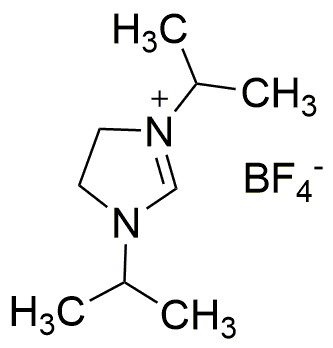1,3-Diisopropylimidazolinium tetrafluoroborate is widely utilized in research focused on:
- Electrolytes for Energy Storage: This compound serves as an electrolyte in lithium-ion batteries, enhancing their efficiency and lifespan. Its unique ionic properties allow for better ion conductivity compared to traditional electrolytes.
- Catalysis in Organic Reactions: It acts as a catalyst in various organic synthesis reactions, particularly in the production of fine chemicals. Its stability and reactivity make it a preferred choice for researchers looking to optimize reaction conditions.
- Solvent for Ionic Liquids: Used as a solvent in ionic liquid formulations, it improves solubility and stability of various compounds, making it valuable in the field of green chemistry where reducing solvent waste is crucial.
- Electrochemical Sensors: This chemical is employed in the development of electrochemical sensors, providing high sensitivity and selectivity for detecting specific analytes, which is essential in environmental monitoring and biomedical applications.
- Material Science: It is utilized in the synthesis of advanced materials, such as conducting polymers and nanocomposites, leading to innovations in electronics and materials engineering.
General Information
Properties
Safety and Regulations
Applications
1,3-Diisopropylimidazolinium tetrafluoroborate is widely utilized in research focused on:
- Electrolytes for Energy Storage: This compound serves as an electrolyte in lithium-ion batteries, enhancing their efficiency and lifespan. Its unique ionic properties allow for better ion conductivity compared to traditional electrolytes.
- Catalysis in Organic Reactions: It acts as a catalyst in various organic synthesis reactions, particularly in the production of fine chemicals. Its stability and reactivity make it a preferred choice for researchers looking to optimize reaction conditions.
- Solvent for Ionic Liquids: Used as a solvent in ionic liquid formulations, it improves solubility and stability of various compounds, making it valuable in the field of green chemistry where reducing solvent waste is crucial.
- Electrochemical Sensors: This chemical is employed in the development of electrochemical sensors, providing high sensitivity and selectivity for detecting specific analytes, which is essential in environmental monitoring and biomedical applications.
- Material Science: It is utilized in the synthesis of advanced materials, such as conducting polymers and nanocomposites, leading to innovations in electronics and materials engineering.
Documents
Safety Data Sheets (SDS)
The SDS provides comprehensive safety information on handling, storage, and disposal of the product.
Product Specification (PS)
The PS provides a comprehensive breakdown of the product’s properties, including chemical composition, physical state, purity, and storage requirements. It also details acceptable quality ranges and the product's intended applications.
Certificates of Analysis (COA)
Search for Certificates of Analysis (COA) by entering the products Lot Number. Lot and Batch Numbers can be found on a product’s label following the words ‘Lot’ or ‘Batch’.
*Catalog Number
*Lot Number
Certificates Of Origin (COO)
This COO confirms the country where the product was manufactured, and also details the materials and components used in it and whether it is derived from natural, synthetic, or other specific sources. This certificate may be required for customs, trade, and regulatory compliance.
*Catalog Number
*Lot Number
Safety Data Sheets (SDS)
The SDS provides comprehensive safety information on handling, storage, and disposal of the product.
DownloadProduct Specification (PS)
The PS provides a comprehensive breakdown of the product’s properties, including chemical composition, physical state, purity, and storage requirements. It also details acceptable quality ranges and the product's intended applications.
DownloadCertificates of Analysis (COA)
Search for Certificates of Analysis (COA) by entering the products Lot Number. Lot and Batch Numbers can be found on a product’s label following the words ‘Lot’ or ‘Batch’.
*Catalog Number
*Lot Number
Certificates Of Origin (COO)
This COO confirms the country where the product was manufactured, and also details the materials and components used in it and whether it is derived from natural, synthetic, or other specific sources. This certificate may be required for customs, trade, and regulatory compliance.


